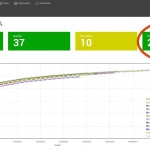Let’s start with what we know, RNA-seq offers a number of advantages over microarrays (high-technical reproducibility, dynamic range and discovery of novel transcripts) when you’re investigating transcriptomes. While we believe they’re important, those advantages do come with new questions to tackle. One of the trickiest questions we address at Cofactor when designing a project is how do we balance sequencing depth and biological replicates to get the most out of a budget?
We’ve advocated in the past that it’s important to know the diminishing returns of deeper sequencing depth. It’s why saturation curves come standard with every RNA-seq project (pictured below). We’re also big proponents of using replicates, and the p-values they allow, to gain more insight in to you data.
That’s why we’re pleased to see a recent paper by Liu, et al that assesses the ability to detect differentially expressed transcripts by comparing adding additional replicates vs increasing the sequencing depth. They found that adding replicates significantly increased detection of differentially expressed genes at high, medium and low expressed transcripts over adding more sequencing depth. One case they found for which this does not hold true, is low abundance transcripts, which benefit from greater sequencing depth. The whole paper offers some great insight in to what scientists should be thinking about as they’re developing experiments.
When you’re planning your next experiment, ask yourself and your team, what is the question we most need to address? That will go a long way in determining depth and replicates. For example, are you looking for low abundance transcripts, or are you looking more generally, in the range of medium to highly expressed transcripts? These questions, and more, are all things our team thinks about, so get in touch today with one of our project scientists to start planning your project.




